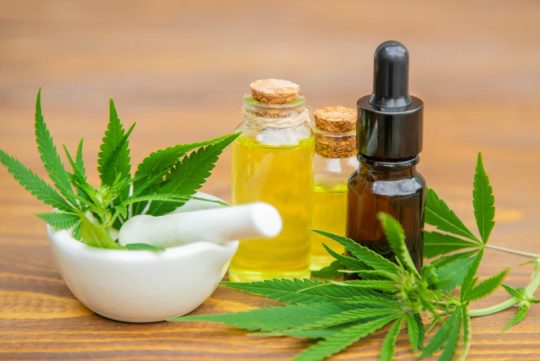
Why Use Cannabis Oil

Which Oil is the Best for Cannabis?

Why Use Heat During the Extraction Process?

Why Use Oil Over Chemical Solvents?

How Does Coconut Oil Bind to Cannabinoids?

How to Make Cannabis Oil, Sourcing your Ingredients

How to Make Cannabis Oil Using Coconut Oil in 10 Easy Steps

How to Use Your Cannabis Oil
Why Use Cannabis Oil
For those of you that are already set on cannabis oil as your preferred method for consuming cannabis – you can skip this section.
Cannabis oil is an ideal way to consume cannabinoids and terpenes because it’s concentrated and versatile.
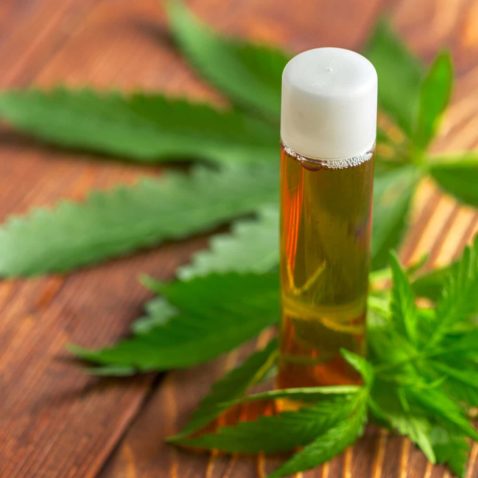
Not all marijuana enthusiasts enjoy dabbing flowers or dabbing shatter. Furthermore, many of the edibles on the medicinal or recreational market are filled with unhealthy ingredients.
Cannabis oil, on the other hand, doesn’t require combustion and contains minimal ingredients. Aside from health concerns, cannabis oil is incredibly versatile.
Cannabis oil can be used in a number of different ways, such as topical placement, ingestion, and vaping.
This allows cannabis oil users with a plethora of routes to use when they are ready to indulge in their favorite substance – THC or CBD.
Which Oil is the Best for Cannabis?
There are many types of oils that are perfectly suited toward making cannabis oil.
Cannabinoids need fatty acid molecules to bind to during the extraction process, so it’s necessary to find the oil with the highest fatty acid concentration.
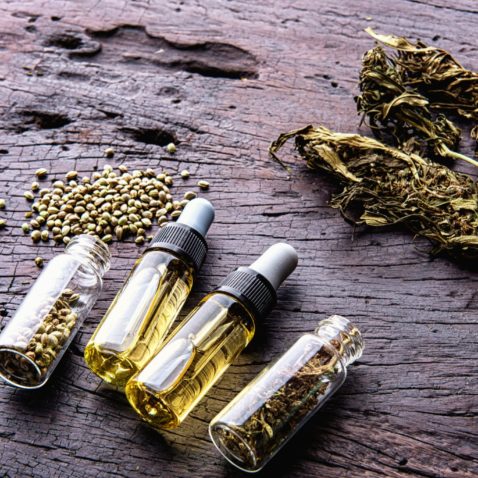
Here is a list of potential oils to choose from:
- Coconut oil
- Avocado oil
- Olive oil
- Sesame oil
- Canola oil
- Peanut oil
- Pumpkin oil
- Ghee
- Walnut oil
- Grapeseed oil
As you can see, there are many different oils to make cannabis oil. However, the number one oil in this list that’s noticeably high in fatty acids is coconut oil.
A single tablespoon of coconut oil contains over 90% of your daily saturated fats, which means it’s dense with fatty acids.
Additionally, coconut oil has a smoke point of 450 °F, whereas olive oil is much lower at 410 °F.
This extra buffer will keep your kitchen from being filled with smoke in the event you overdo the heat during the extraction process.
Once again, we are not saying that you can’t use other oils to extract cannabinoids.
However, we are saying that coconut oil proves it’s worth as a nutrient-dense superfood and ideal cannabinoid extractor.
Furthermore, coconut oil is very affordable and can be found at grocery chains and specialty health-food stores.
Another reason why cannabis coconut oil is trending right now is that coconut oil is one of the best oils to use topically.
The properties within coconut oil absorb quickly into the skin without leaving a greasy residue – such as olive oil.
Edible, topical, and easy to vape – these are the three hallmarks of cannabis coconut oil that made us look twice.
Why Use Heat During the Extraction Process?
Although cannabinoids bind quickly to fatty acid molecules, heat is a necessary element to activate the cannabinoids.
This process is called decarboxylation and it converts inert THC-A or CBD-A into THC or CBD.
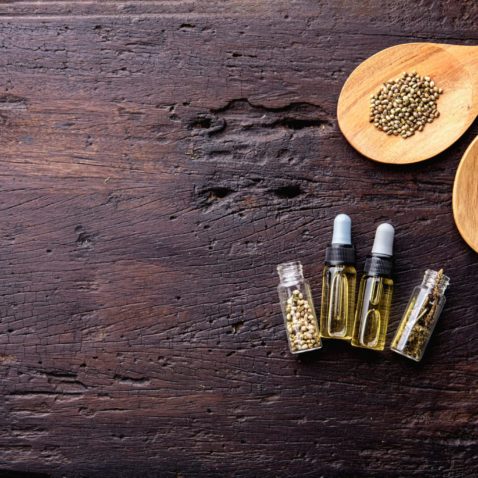
Once activated, the cannabis coconut oil can be directly ingested, absorbed by the skin, and vaped for a rapid effect.
However, too much heat degrades the potency of THC and CBD, which is why it’s essential that you monitor the temperature of the oil mixture during the extraction process.
Why Use Oil Over Chemical Solvents?
We’re not going to sugarcoat the answer to this question. Chemical-based solvents, such as butane, are dangerous.
Yes, many of today’s extracts are created by solvents like butane and ethanol, but this method is slowly but surely being phased out.
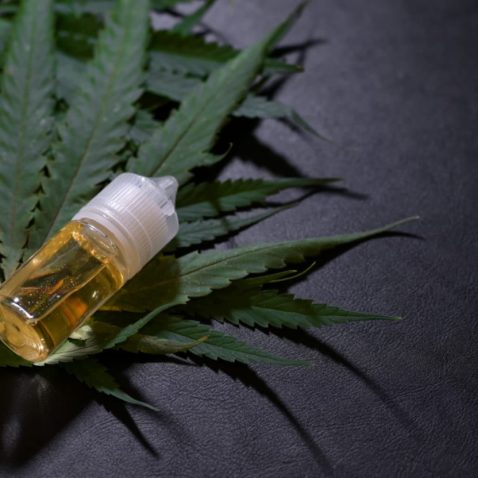
Lawmakers across the nation are tightening their grip on concentrate regulations because of the inherent dangers of using highly-flammable and toxic chemicals to create marijuana oils and concentrates.
Nobody knows how long residual content from butane lasts inside your body after you consume it.
However, do you want to take that risk? Your health is worth far more than anything else, so it’s ideal to not gamble it on a chemical product that is little understood.
The reason to use natural oils, such as coconut oil, to make cannabis oil is that it’s a simple process.
Although you’ll need to take certain precautions while making a batch of coconut oil, it’s nowhere near as intricate as the lab tools required for solvent-based extracts.
Learning how to make cannabis oil with coconut allows you to create a totally natural product.
The cannabinoids come from marijuana plants, and the coconut oil comes from the coconut tree. Both of these products require minimal processing by the time they reach you.
How Does Coconut Oil Bind to Cannabinoids?
Without having to go in-depth into the science behind this phenomenon, coconut oil contains over 80% saturated fat.
This is an incredibly high fatty acid content, which allows cannabinoids to bind to it efficiently.

Cannabinoids are hydrophobic, which is why you can’t create extracts with water.
Cannabinoids, terpenes, and flavonoids need something special to attach to something – such as a solvent, fat, freezing temperatures, or heat.
In this case, cannabinoids quickly latch onto the fat that coconut oil provides.
The keyword here is that cannabinoids are fat-soluble.
How to Make Cannabis Oil, Sourcing your Ingredients
Now that you’re ready to dive into the “doing” part of the process, let’s take a look at what you need.
- Organic coconut oil (unrefined)
- High-quality cannabis flowers or trichome dense trim

Isn’t it nice to know that you only need two ingredients? That’s precisely what we think too.
You won’t have to worry about harmful chemicals, such as propylene glycol or vitamin E acetate in your marijuana product.
Aside from these two ingredients, you’ll need a few tools to begin.
- Stainless steel mixing spoon
- 2 Heat resistant bowls (Pyrex)
- Small to a medium-sized cooking pot
- Cheesecloth or fine mesh strainer
- A small-medium jar or multiple small jars
- Fire extinguisher
- Goggles
- Apron
- Baking mittens or gloves
- Thermometer
How to Make Cannabis Oil Using Coconut Oil in 10 Easy Steps
It’s time to learn how to make cannabis oil – and the best part? You’ll be done in no time.
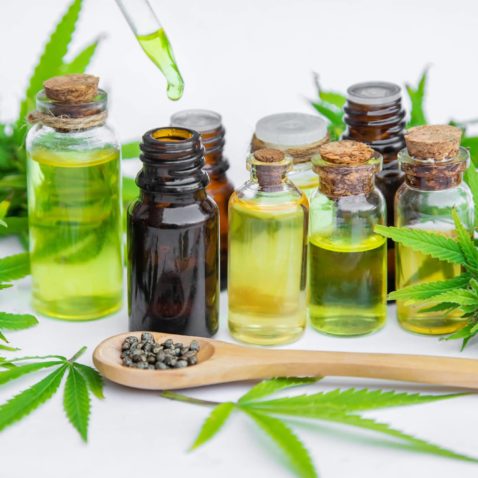
Step 1
Prep your kitchen. You want to ensure that all of your materials are laid out in an organized way. The last thing you want is to scramble around after you begin.
It’s best to make a checklist and account for everything. This will keep the process stress free and efficient.
Make sure you have a fire extinguisher close by. We’ve never had any close calls, but why not have it for peace-of-mind? Keep it close in the event that something goes wrong.
Once everything is organized neatly, you may begin.
Step 2
Grind 1 cup of cannabis flowers or 2-3 cups of trim. You don’t need an ultra-fine grind, but you don’t want too fine because you don’t want to have to keep straining the end product. Set your cannabis material aside.
Scoop 1 cup of coconut oil and set aside.
Step 3
Fill the cooking pot halfway to three-quarters with water. Allow this to begin boiling.
Step 4
Once the water is boiling, place the Pyrex bowl on top of the cooking pot. The bowl should fit snugly above without falling into the boiling water.
This method is known as a double-boiler. Instead of receiving direct heat, the Pyrex bowl uses the heat from steam.
This method keeps your cannabis coconut oil from combusting.
Step 5
Place the coconut oil into the Pyrex bowl. Next, place the semi-grinded cannabis material into the bowl. Allow the coconut oil to melt and gently mix the contents.
Step 6
Allow up to 6-hours. This process does take time, so make sure you have an excellent book, or NetFlix lined up. Never leave the house under any circumstances.
You have an open flame on, so it’s essential that you monitor your oil mix ever 25-minutes. Stir every time you check on the mixture.
Always take a temperature reading when you check on the mix.
Additionally, you’ll need to monitor the water content in the cooking pot. Over time, the water will evaporate, so it’s essential that you refill the cooking pot as it decreases.
Never allow cannabis coconut oil to surpass 250 °F. If it does, you will lose potency, flavor, and terpene content.
Step 7
After 6-8-hours, it’s time to remove the Pyrex bowl. Place another Pyrex bowl on the counter and drape it with cheesecloth or a fine-mesh strainer.
Step 8
Pour the cannabis coconut oil mix into the second Pyrex bowl through the strainer. If using cheesecloth, try not to squeeze the remaining oil out, as this will push out chlorophyll.
Once done straining, discard the cannabis material.
Step 9
If you find small cannabis material inside your coconut oil, you can strain it again until it’s free of debris.
Step 10
Pour the final product into a container of your choice. Store it in a cool and dark area. As the temperature drops, you’ll notice that your oil will solidify.
That’s it! You now know how to make cannabis oil with coconut oil.
Remember: cannabis coconut oil will remain solid at room temperature. If you add heat, the oil will become liquid.
Therefore, you can use this mixture as a topical at room temperature, and you can vape it by increasing its temperature.
How to Use Your Cannabis Oil
Now that you made a high-quality batch of cannabis coconut oil, it’s time to use it!
Remember, you won’t know the potency of your oil unless you have it lab-tested.
Regardless of the method that you use to consume it, make sure you always start at a low dose.

How to Use Your Cannabis Oil for Vape Pens
For those of you that want to know how to make cannabis oil for vape pens – you just made it! Cannabis coconut oil can be used for vape pens easily.
Simply scrape a small dab of cannabis coconut oil and place it into your vaporizer and vape as normal.
Since your cannabis coconut oil is composed of two ingredients, you won’t need to worry about any sketchy compounds that can potentially affect your health.
How to Eat Your Cannabis Coconut Oil
This method is by far the easiest. Simply eat it! Not only can you eat the oil directly, but you can also infuse any meal that calls for coconut oil.
Now, every meal can be a cannabis-infused meal with the help of cannabis coconut oil.
Using Cannabis Coconut Oil For Topical Use
Since coconut oil is readily absorbed into the skin, your cannabis coconut oil will prove to be an effective topical.
Whether you’re fighting chronic pain or want hydrated skin – place a small dab of oil onto your skin.
Rub the oil into your skin in a circular motion until it’s fully absorbed. As always, use a small amount at first until you understand its’ strength.
How to Make Medicinal Cannabis Oil
There isn’t a difference in medicinal cannabis oil and recreational marijuana oil.
The difference is from a legal perspective, so if you reside in a medical marijuana state – you can follow the directions above to make medicinal cannabis oil with coconut oil.
Summary
There’s no doubt that coconut oil has become the preferred oil for many cannabis-concentrates.
Now that you understand how to make cannabis oil with coconut oil, you know that you can use it for a number of applications.
Eating, vaping, and rubbing THC into your skin has never been so easy – and safe.
Do you have any recipes for your cannabis coconut oil?
How about extraction techniques?
Share the Love
If you found this post useful, please let others know about it by sharing it.
